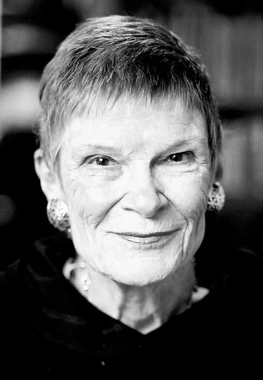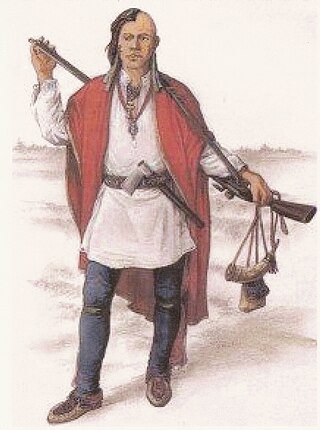
The Mi'kmaq are a First Nations people of the Northeastern Woodlands, indigenous to the areas of Canada's Atlantic Provinces, primarily Nova Scotia, New Brunswick, Prince Edward Island, and Newfoundland, and the Gaspé Peninsula of Quebec as well as Native Americans in the northeastern region of Maine. The traditional national territory of the Mi'kmaq is named Miꞌkmaꞌki.

Glooscap is a legendary figure of the Wabanaki peoples, native peoples located in Vermont, New Hampshire, Maine and Atlantic Canada. The stories were first recorded by Silas Tertius Rand and then by Charles Godfrey Leland in the 19th century.
Rexford G. Newcomb was an American architectural historian.

Constance Bowman Reid was the author of several biographies of mathematicians and popular books about mathematics. She received several awards for mathematical exposition. She was not a mathematician but came from a mathematical family—one of her sisters was Julia Robinson, and her brother-in-law was Raphael M. Robinson.
Gloria Lund Main is an American economic historian who is a professor emeritus of history at University of Colorado Boulder. She authored two books about the Thirteen Colonies.
Matthew T. Kapstein is a scholar of Tibetan religions, Buddhism, and the cultural effects of the Chinese occupation of Tibet. He is Numata Visiting Professor of Buddhist Studies at the University of Chicago Divinity School, and Director of Tibetan Studies at the École pratique des hautes études.
Fred Dycus Miller Jr. is an American philosopher who specializes in Aristotelian philosophy, with additional interests in political philosophy, business ethics, metaphysics, and philosophy in science fiction. He is a professor emeritus at Bowling Green State University.

Glooscap First Nation is a Canadian Mi'kmaq aboriginal community located in both Kings County and Hants County, Nova Scotia. Also known as Kluskap, its reserve is located approximately 6.4 kilometres (4.0 mi) from the Town of Hantsport. Created in 1907 as Horton 35, the reserve encompasses some 171.1 hectares of rolling, mainly forested land. Forest management is practiced by the band. There is a variety store, gas bar, Greco Pizza, and gaming centre. There is also a health centre, youth centre and chapel. The Glooscap Landing Business Park is also owned by Glooscap First Nation which houses a second gas bar and Tim Hortons. The 2023 population was 434 people of whom approximately 100 lived on the reserve, making Glooscap the third-smallest First Nation community in Nova Scotia after Bear River First Nation and Annapolis Valley First Nation. Glooscap's population grew by 41% in one decade between 2013 and 2023.

Ehud R. Toledano is professor of Middle Eastern history at Tel Aviv University and the current director of the Program in Ottoman & Turkish Studies. His areas of specialization are Ottoman history, and socio-cultural history of the modern Middle East.
Cheryl Savageau is an American writer and poet who self-identifies as being of Abenaki descent.

The military history of the Mi'kmaq consisted primarily of Mi'kmaq warriors (smáknisk) who participated in wars against the English independently as well as in coordination with the Acadian militia and French royal forces. The Mi'kmaq militias remained an effective force for over 75 years before the Halifax Treaties were signed (1760–1761). In the nineteenth century, the Mi'kmaq "boasted" that, in their contest with the British, the Mi'kmaq "killed more men than they lost". In 1753, Charles Morris stated that the Mi'kmaq have the advantage of "no settlement or place of abode, but wandering from place to place in unknown and, therefore, inaccessible woods, is so great that it has hitherto rendered all attempts to surprise them ineffectual". Leadership on both sides of the conflict employed standard colonial warfare, which included scalping non-combatants. After some engagements against the British during the American Revolutionary War, the militias were dormant throughout the nineteenth century, while the Mi'kmaq people used diplomatic efforts to have the local authorities honour the treaties. After confederation, Mi'kmaq warriors eventually joined Canada's war efforts in World War I and World War II. The most well-known colonial leaders of these militias were Chief (Sakamaw) Jean-Baptiste Cope and Chief Étienne Bâtard.
Trina Roache is a Mi'kmaq video journalist, educated at University of King's College. She has worked with CBC, as a freelancer and with APTN National News at the Aboriginal Peoples Television Network covering the issues and stories of the Mi’kmaq, Wolastoqey (Maliseet) and Peskotomuhkati people in the Atlantic Canada. She is a member of the Glooscap First Nation.
Jodi Ann Byrd is an American indigenous academic. They are an associate professor of Literatures in English at Cornell University, where they also hold an affiliation with the American Studies Program. Their research applies critical theory to indigenous studies and governance, science and technology studies, game studies, indigenous feminism and indigenous sexualities. They also possess research interests in American Indian Studies, Post-Colonial Studies, Digital Media, Theory & Criticism.
Zine Magubane is a scholar whose work focuses broadly on the intersections of gender, sexuality, race, and post-colonial studies in the United States and Southern Africa. She has held professorial positions at various academic institutions in the United States and South Africa and has published several articles and books.

Raissa Samojlovna Calza was a Ukrainian dancer who became a prominent classical archaeologist of Roman portraiture. When she was young, she fled to Italy and France following the Russian Revolution.
Mo Moulton is an American author and historian of 20th century Britain and Ireland, interested in gender, sexuality, and colonialism/postcolonialism. They are a senior lecturer in the history of race and empire at the University of Birmingham.
Rollo Gabriel Silver was an American literary historian.
Robert Dankoff is Professor Emeritus of Ottoman & Turkish Studies, Department of Near Eastern Languages and Civilizations at University of Chicago.
Bettina Renz is a German political scientist and Professor of International Security at the School of Politics and International Relations, University of Nottingham. Her major research expertise is post-Soviet Russian security and defence policy, military reform and civil-military relations. Since 2005, Renz has published numerous articles in academic journals describing the background and effects of changes in contemporary Russia's military. She is an editorial board member of the United States Army War College Press.
Misha Nogha Chocholak is an American science fiction writer. Of Métis background, she is known for her 1990 cyberpunk novel Red Spider White Web.







